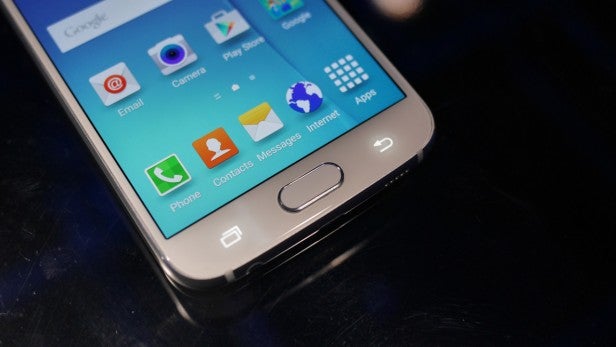Samsung Galaxy S6 vs Galaxy S5: Should you upgrade?

Galaxy S6 vs S5: Is it worth the upgrade? Both are great Android phones, but we take a look at the big features that could sway you to go for one over the other
Samsung’s flagship phone for 2015 is the Galaxy S6 and it’s one of the best smartphones we’ve lived with. Announced alongside its curved screen brother the Galaxy S6 Edge, it’s one of the most advanced phones we’ve ever seen.
There’s a totally new design the breaks away from Samsung tradition, a super-powered processor and an improved screen. But how much better is it than the Galaxy S5?
Well, just about every aspect of the phone is improved, making it a great upgrade if you can afford to part with the cash. However, if you’re looking to save a bit of money, the Galaxy S5 is much, much more affordable these days. It’s also water-resistant, comes with an SD card slot and removable battery.
Having lived with both the 2014 and 2015 Samsung flagships, here’s where we think you see the biggest differences between the two Android phones.
Related: Samsung Galaxy S7 vs iPhone 6S
Samsung Galaxy S6 vs S5 – Price
Over a year on, the Galaxy S5 has come down an awful lot in price. Shop around and you can find it for around £310 unlocked. The Galaxy S6 costs £509.99 PAYG from Three or £469 unlocked from giffgaff, that’s a nice drop from the initial £600 price tag. We also found it going on Amazon for £414 (unlocked). That’s for the base 32GB version too. You’re looking at up to £649 (giffgaff) for the top-end 128GB S6.
There’s also a big difference in contract prices. At the time of writing, you can get a Galaxy S5 from Vodafone for £29 a month with a £49 up-front fee, while the Galaxy S6 comes with a £45-a-month contract and a £9 fee.
Watch our Galaxy S6 hands-on video
Related: iPhone 6S vs Galaxy S7
Samsung Galaxy S6 vs Galaxy S5 – Design
Galaxy S6 Design: 138g, 143.4 x 70.5 x 6.8mm (HxWxD)
Galaxy S5 Design: 145g; 142.0 x 72.5 x 8.1mm (HxWxD); Water & dust resistant
It hasn’t been a great 12 months for Samsung in the money stakes. It makes billions still, sure, but no-one likes a downturn in profits. One of its big hopes to turn things around is a new approach to phone design.
Nowhere is this seen more clearly than in the comparison of the Galaxy S6 and Galaxy S5. In early 2014 when the Galaxy S5 was announced, Samsung was waist-deep in its ‘experimentation with plastic’ phase. What resulted was the rather odd pitted back of the S5.
It looks strange now, and seemed flat-out odd back in 2014. In most of the Galaxy S5 shades it doesn’t actually feel too bad, the soft-touch finish giving a shot of tactility and texture. The white version, though, feels a lot harder. It’s plain “not nice” according to much of the TrustedReviews team.
Even the darker Galaxy S5s don’t exactly look or feel all that expensive, though. The very thin plastic rear and the fake chrome sides just don’t have the premium vibe you might expect when spending hundreds of pounds on a phone.
The Galaxy S6 changes all that, using some of the most conspicuously expensive materials seen in what is still ultimately an entirely mainstream phone. Its back and front are Gorilla Glass 4, a toughened glass made by Corning, while the sides are aluminium rather than plastic.
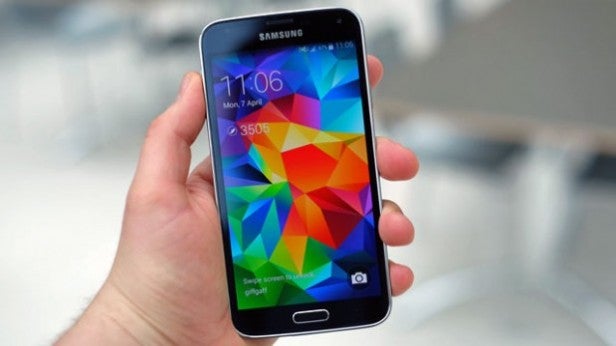
Every part of the Galaxy S6 feels hard and dense. It’s a clear step up from the Galaxy S5. Of course, you wouldn’t want to drop it, but Samsung has packed pretty much the best glass into the phone for scratch and shatter resistance.
During our time with the device we have, sadly, dropped it on a few occasions. A drop onto concrete from barely a foot resulted in a spiralling crack on the back. This crack continued to grow with the phone in our pocket and it now snakes over the entire rear. Our advice is to pick up a case, especially if you’re the clumsy kind.
If you want to embrace glass even more, Samsung also makes a curved-edge version of the Galaxy S6 called the Galaxy S6 Edge along with a larger Galaxy S6 Edge+. The S6 Edge is more expensive, but the sides of the front curve around, making it appear even more “all-glass”.
There’s a handling benefit too. The Galaxy S6 and S6 Edge feel very slight and easy to handle, while the slightly blockier design of the Galaxy S5 means it’s a bit more of a handful. It’s not something pick one over the other, though. All handle pretty well.
The one other slightly contentious design element of the Galaxy S6 is that its camera lens sticks out. The Galaxy S5’s doesn’t, and after using the new phone for a couple of weeks some of the coloured border has started to flake off. Despite all that toughened glass, the S6 is not 100% pocket-proof.
However, we don’t have too many worries about scratching the actual lens. The design seems to take pains to ensure it’s no more vulnerable than a flush phone lens.
The Galaxy S5 has one neat extra, though. It’s water resistant, meaning it can be dropped in the bath with no ill effects as long as the flap on the bottom USB port is sealed. The S6 isn’t water resistant, so you’ll need to be a bit more careful with it.
Related: Samsung Galaxy S6 tips and tricks
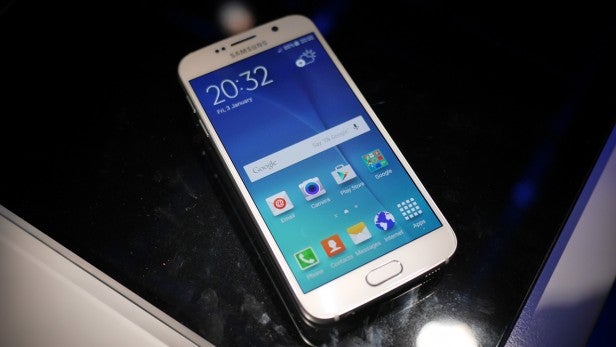
Samsung Galaxy S6 vs Galaxy S5 – Screen
Galaxy S6 Screen: 5.1-inch, 2,540 x 1,440 Super AMOLED; 577ppi; 600 nits brightness
Galaxy S5 Screen: 5.1-inch, 1,920 x 1,080 Super AMOLED; 432ppi; 600 nits brightness
Samsung makes some of the best mobile phone screens in the world. Arguably it makes flat-out the best. It’s the main supporter of AMOLED screen technologies, using them in all its top-end phones.
After a few years of producing phones with the negative hallmarks of Samsung’s own kind of PenTile Super AMOLED displays, phones like the Galaxy S5 offer displays with no major downsides. Contrast is impeccable, colour is thoroughly customisable, outdoors visibility good and pixel density so high that the reduced sharpness of PenTile AMOLEDs simply isn’t an issue.
The Galaxy S6’s approach is identical, but simply adds on a year of tech development. The most obvious change is resolution. 2014’s Galaxy S5 has a 1080p display where the Galaxy S6 uses a QHD one.
There is a difference, but don’t go thinking it’ll change your world or you may go away disappointed. Get up close to the Galaxy S5 screen and you can see a hint off granularity caused, in part, by the PenTile sub-pixel array. This is a tech Samsung owns, and while it makes OLED screens easier to produce and longer-lasting, it does result in a slight loss of sharpness.
Related: Samsung Galaxy S4 owners: Do you go S5 or S6?
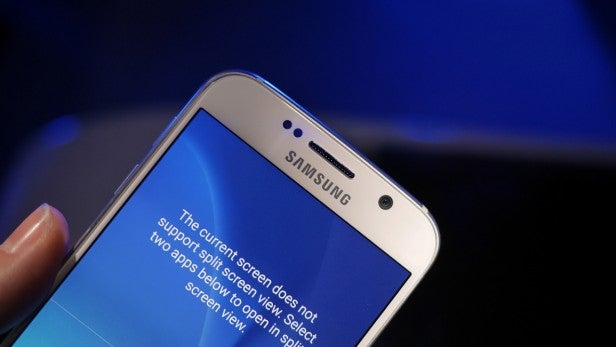
The Galaxy S5’s 1080p screen had already largely solved this issue, but the QHD S6 negates it all the more. Next year we’ll probably see an even sharper UHD Galaxy S7, but we’ll leave the argument as to whether there’s much point in that for another time.
Other improvements in the Galaxy S6 include improved colour accuracy in the most natural screen mode and better outdoors visibility on bright, sunny days. The S6 is extremely aggressive in manipulating screen brightness and colour intensity to keep the display clear outdoors.
It’s not that the Galaxy S5 is bad in this area. The new phone is just better.
Being OLED displays, things like black level are the same, although increased max brightness in the Galaxy S6 brings an extra hit of perceived contrast. Once again, for a real flashy look you might want to consider the Edge version of the S6. It has the same display style and resolution as the normal S6, but the way its curves play with reflections make it appear all the fancier.
It also seems to use to be slightly better at dealing with reflections.
Samsung Galaxy S6 vs S5: Storage
The Samsung Galaxy S5 is not going to win many areas in this comparison, but one it has in the bag is storage. This year Samsung is changing its approach to storage for top-end phones.
In order to encourage people to ‘super-size’ to a larger storage variant of the Galaxy S6, Samsung has removed the microSD slot from the phone. There are 32GB, 64GB and 128GB versions to choose from, but you’ll naturally have to pay an awful lot for the top model.
This is the first time a Samsung Galaxy S flagship has omitted a card slot. The Galaxy S5 has one, which is why the 16GB version of the phone is by far the most commonly-sold.
Of course, if you’re rich or don’t care about being able to store thousands and thousands of music tracks or dozens of films, it’s no big issue. But it’s also one of the few major off-putting parts of the Galaxy S6.
Related: 9 Ways to take better photos with the Galaxy S6
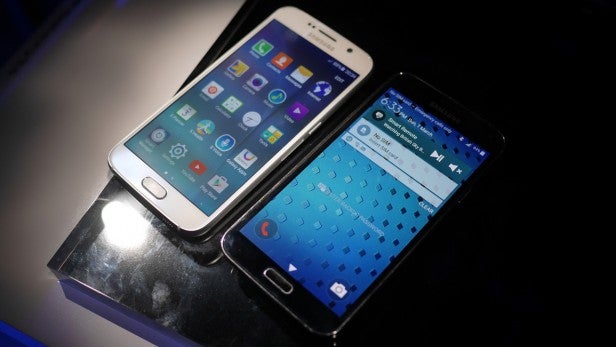
Samsung Galaxy S6 vs S5: Fingerprint scanner
The Samsung Galaxy S5 was one of the first Android phones to use a fingerprint scanner. It is so very ‘Samsung’ to feel the need to pack in every feature possible. And it’s also so very Samsung to not quite get it right on first try.
Sure enough, the Galaxy S5 fingerprint scanner was terrible. Some people get on with it just fine, but others find it frustrating in its need for quite a particular, measured gesture. The issue: you need to swipe a finger over the scanner, not just rest the finger on it. The scanner sits under the main home button, so it’s not awkwardly positioned, but we find it frustrating nevertheless.
The Samsung Galaxy S6 uses a different scanner technology, although it still lives in the same place under the Home button. In the new phone you don’t need to swipe a finger, just rest it on the scanning plate, making sure to cover the whole surface. It works much better, getting rid of the frustration of the Galaxy S5’s one.
Samsung Galaxy S6 vs Galaxy S5 – CPU, GPU and RAM
Samsung Galaxy S6 CPU, GPU and RAM: 14nm Exynos 7420 Octo-core CPU; Mali-T760 GPU; 3GB DDR4 RAM
Samsung Galaxy S5 CPU, GPU and RAM: Snapdragon 801 quad-core CPU; Adreno 330 GPU; 2GB DDR3 RAM
2015 also marks a bit point of change for the Samsung approach to CPUs. Where the Galaxy S5 used both Samsung Exynos and Qualcomm Snapdragon processors depending on the territory (different countries have slightly different variants), the Galaxy S6 currently uses the Exynos 7420 processor throughout the world.
Whether this is a political issue or purely a technical one is up for debate, but there are certainly solid justifications for using the Exynos chipset. Most convincing of the lot is that the Exynos 7420 uses a 14nm construction process, making it more efficient than the 20nm rival Snapdragon 810.
The Galaxy S5 uses the Snapdragon 801, which is also a 20nm chipset, and one using a 32-bit architecture rather than a 64-bit one.
Of course, all this tech innovation may not mean a great deal if it doesn’t equate to real-life performance benefits. Benchmarks get us at least one step closer to seeing the performance potential of these phones.
Related: 5 big Samsung Galaxy S5 features dropped in the S6
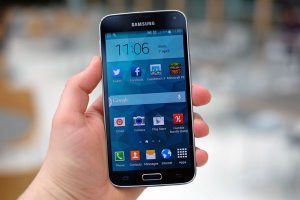
In Geekbench 3 you’ll squeeze roughly 2900 points out of the Galaxy S5, while we’ve managed 5200 points with the Galaxy S6. That’s a huge difference, and even more than we expected given the rival Snapdragon 810 phones only manage around 4400.
The difference in day-to-day use is much less marked, of course. The Galaxy S5 is still a very powerful phone that can handle just about any game out there. As this year progresses we’ll probably see a few more titles that have some extra graphical touches, but it won’t make a whole world of difference.
Both phones are somewhat susceptible to the usual Samsung effect of a bit of slow-down after you’ve used the phone for a while. However, it’s fairly minor, and more just a sign that you shouldn’t really obsess over the numbers too much.
Samsung Galaxy S6 vs S5 – Battery Life
Galaxy S6 Battery: 2,550mAh non-removable, fast charging; Wireless charging support
Galaxy S5 Battery: 2,800mAh replaceable battery
One surprising element of the Galaxy S6 is that it has a 2,550mAh battery, smaller than the 2,800mAh unit of the Galaxy S5. This seems like it might end in insta-disaster, but thanks to its efficient 14nm Exynos 7420 processor, in many situations the Galaxy S6 performs extremely well.
For example, it lasted for 13 hours of looped video where we got 11 hours out of the Galaxy S5. However, this quite stunning performance seems to be down to clever optimisation of the processor’s workings rather than a totally accurate representation of the phone’s stamina.
Take a new, non-knackered Galaxy S5 and you should find its stamina to be a bit better than the Galaxy S6’s. However, it’s more a case of limited progress rather than a real step back.
Using the battery saver mode, we squeezed a respectable day and a half out of the Galaxy S6, but enthusiast users will be able to drain the battery in a day. This is one of the S6’s weaker areas, where the S5 is very solid.
Related: Best Mobile Deals: Top Smartphone offers this month
Samsung Galaxy S6 vs S5 – Connectivity
Samsung Galaxy S6 Connectivity: Wi-Fi 802.11 a/b/g/n/ac, Wi-Fi direct, A-GPS, ANT+, microUSB v2.0, USB Host, Bluetooth 4.1
Samsung Galaxy S5 Connectivity: Wi-Fi 802.11 a/b/g/n/ac, Wi-Fi direct, A-GPS, ANT+, microUSB v3.0, USB Host, Bluetooth 4.0
The Galaxy S6 and S5 both have pretty exceptional connection rosters, especially on the wireless side. You get Wi-Fi up to the latest ac standard, 4G is in and both have an IR transmitter.
One benefit of the older Galaxy S5 is that it has a micro USB 3.0 port where the newer phone switches back to a USB 2.0 one. USB 3.0 gets you faster transfer speeds and faster charging when attached to a USB 3.0 port, but uses a non-standard socket. Thankfully, it’s effectively a USB 2.0 port with a conjoined twin. You can still use normal microUSB cables with it.
The Galaxy S6 has a few notable extras too. It offers CAT6 4G rather than CAT4 4G, getting you slightly faster maximum speeds. Will it change much when you’re dealing with UK networks? No, but there’s no drawback either.
Support for the main wireless charging systems is a bit more interesting. The Galaxy S6 works with PMA and Qi wireless charging pads. That comprises most of the pads you’ll find on sale, giving you plenty of scope to stray away from official accessories. The Galaxy S5 does not offer wireless charging.
Related: How to switch from iPhone to Android
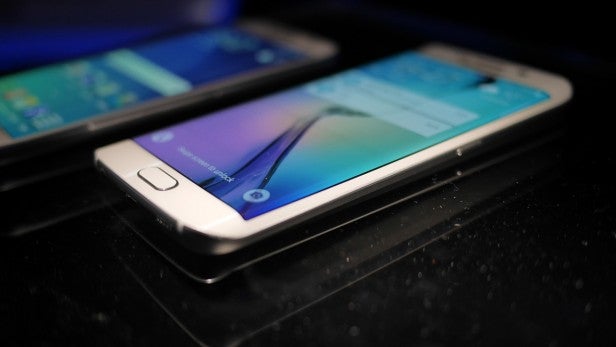
Samsung Galaxy S6 vs S5: Software
The Samsung Galaxy S5 and S6 both naturally run Android and the TouchWiz custom user interface seen on just about all Samsung phones. They look fairly similar too. Both phones now have Android 5.0 and Samsung didn’t make any radical changes to the custom UI for 2015.
There are some additions for the Galaxy S6, though. First up: themes. As usual, these alter things like the wallpaper, font and icons. You’re not missing out on much, though. At present there aren’t many good ones available, although this may change soon as more are added.
Microsoft Office apps also come preinstalled, although you can always add those yourself if you fancy, with just about any phone.
The Galaxy S6 also has some new phone management apps, designed to let you free-up memory and check that no app is doing something it shouldn’t. However, these are not really essential, and there are plenty of third-party alternatives available.
Perhaps the most important change comes from Android 5.0 Lollipop rather than Samsung. The way the phone moves just feels different, and more fluid, than the Galaxy S5 did when it was first released.
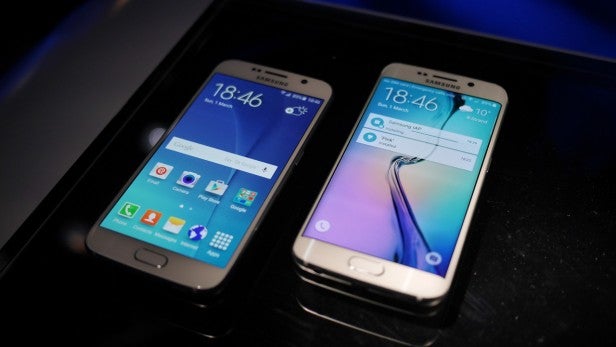
Samsung Galaxy S6 vs S5: Camera
The Galaxy S6 and S5 have the same resolution main sensor. Both have 16 megapixels. It seems even Samsung has finally admitted we’ve hit a ceiling on usable phone camera resolutions.
However, there are a few very important changes in the Galaxy S6 that make it an all-round better camera. First, it has a faster lens.
The Galaxy S6 has an f/1.9 lens while the Galaxy S5 has an f/2.2 lens. These numbers refer to the lens aperture. In this case, the lower the number, the larger an aperture the lens has to let in light. This means it’ll be able to use faster shutter speeds and/or lower ISO sensitivity in the same lighting conditions. That’s an all-out win. This more advanced lens could well account for the extra lens space sticking out of the back of the phone.
Then there’s optical image stabilisation. This is where movements in the lens are buffered by a system that stabilises either the sensor or lens. The Galaxy S5 only has software stabilisation.
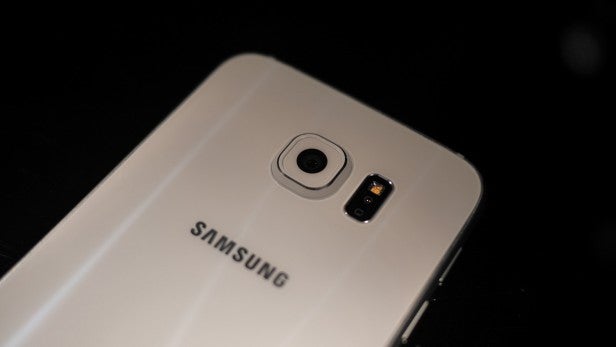
The biggest difference between these two phones is found when you take them outside at night. The Galaxy S6 is much, much faster and produces better photos. With truly low light, the Galaxy S5 can take an absolute age to take photos as (with stabilisation enabled) it takes a multitude of shots, which are then melded together to try to reduce noise and bolster real detail.
Thanks to the OIS and faster lens, the Galaxy S6 simply doesn’t need to do this any more, and it makes the camera a lot more fun to use.
In daylight, there’s a lot less to separate the two cameras. Both are excellent, getting you loads of detail, and very good speed in daylight.
At this point it looks like the cameras don’t actually use the same sensor: the Galaxy S5 we use has a Samsung ISOCELL sensor (some variants have a Sony sensor) where the Galaxy S6 is believed to have a custom version of the Sony IMX240 sensor. However, the results are roughly comparable in optimum conditions.
HDR is powerful in both phones too, although the Galaxy S6 gets a newer Pro mode. This gives you manual control over focusing and other settings, although not exposure time, sadly.
Verdict
The Galaxy S6 is a great improvement over the Galaxy S5 in some respects. It feels better, has an improved camera and offers loads more power. It also looks so much slicker, though we have suffered some cosmetic issues with the glass covered back.
However, if you don’t want to spend quite so much money, the Galaxy S5 is now available at a great price. It’s just over half the price of the Galaxy S6 SIM-free and still feels like a current, up-to-date phone in most respects. Having microSD support will be a big positive for some, too.
Still have some questions about upgrading to the Galaxy S6? Let us know in the comments section below.


